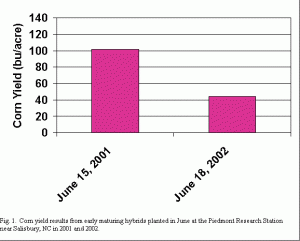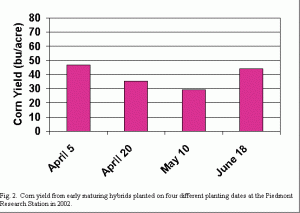Management for Late Planted Corn
go.ncsu.edu/readext?355825
en Español / em Português
El inglés es el idioma de control de esta página. En la medida en que haya algún conflicto entre la traducción al inglés y la traducción, el inglés prevalece.
Al hacer clic en el enlace de traducción se activa un servicio de traducción gratuito para convertir la página al español. Al igual que con cualquier traducción por Internet, la conversión no es sensible al contexto y puede que no traduzca el texto en su significado original. NC State Extension no garantiza la exactitud del texto traducido. Por favor, tenga en cuenta que algunas aplicaciones y/o servicios pueden no funcionar como se espera cuando se traducen.
Português
Inglês é o idioma de controle desta página. Na medida que haja algum conflito entre o texto original em Inglês e a tradução, o Inglês prevalece.
Ao clicar no link de tradução, um serviço gratuito de tradução será ativado para converter a página para o Português. Como em qualquer tradução pela internet, a conversão não é sensivel ao contexto e pode não ocorrer a tradução para o significado orginal. O serviço de Extensão da Carolina do Norte (NC State Extension) não garante a exatidão do texto traduzido. Por favor, observe que algumas funções ou serviços podem não funcionar como esperado após a tradução.
English
English is the controlling language of this page. To the extent there is any conflict between the English text and the translation, English controls.
Clicking on the translation link activates a free translation service to convert the page to Spanish. As with any Internet translation, the conversion is not context-sensitive and may not translate the text to its original meaning. NC State Extension does not guarantee the accuracy of the translated text. Please note that some applications and/or services may not function as expected when translated.
Collapse ▲Introduction
Persistent precipitation and water soaked soils often prevent the timely planting of corn in North Carolina. In cases where corn planting is delayed into late May many growers wonder if it is still possible to plant corn and obtain a profitable yield. Research in Virginia and western North Carolina suggests that corn can be planted from mid to late June with a reasonable opportunity for profit. Figure 1 shows yield data from a study at the Piedmont Research Station conducted in 2001 and 2002. A profitable yield was obtained by planting corn on 15 June in 2001, but yield was low in 2002 due to a drought that also affected yield from earlier plantings (Fig. 2).
These trials show that given good soil moisture it is reasonable to expect that corn could be planted in June with a better-than-average chance of a profit. However, growers should realize that the risk of crop failure increases when corn is planted late. In particular, two problems associated with late-planted corn must be addressed by careful management and in-season scouting if late-planted corn is to be a success. First, there is a much greater chance that corn will be severely damaged by late generations of European Corn Borer and Corn Ear Worm.
The use of a multi-stacked Bt hybrid or field application of insecticide when corn reaches the V8 stage (waist high) is necessary to prevent economic loss or, in some cases, complete crop failure. Second, there is an increased likelihood that corn will experience heat and drought stress in the two week period prior to silking. To minimize the chance of drought and/or heat effecting pollination and kernel number, planting date and hybrid maturity should be selected so that corn reaches silking stage in late July or early August when the chances of rain from tropical storms increase. Other factors to keep in mind are that late-planted corn will be vulnerable to hurricane damage and that harvest will be delayed with expected harvest dates ranging from early to late October. Given these constraints, the following recommendations should be followed for planting corn in June.


Hybrid Selection
It is highly recommended that growers plant a Bt hybrid with good insect tolerance or multiple Bt genes. These hybrids have given the best results in both the Virginia and North Carolina tests and provide adequate protection for corn borer and corn earworm. Growers should select hybrids with maturity ranging from 108 to 114 days. Later maturing hybrids do not show improved yield when planted in June and result in greater delays in harvest. Most corn seed companies have Bt hybrids in this maturity range. Try to select hybrids with excellent standability to provide some protection against hurricanes.
Planting Date and Seeding Rates for Late-Planted Corn
Long-term weather records show that the period from 1 July to 20 July is the most likely to experience lower rainfall amounts, higher average temperatures, and high humidity. Therefore, late-planted corn should be planted so that silking occurs at least a week after the end of this period. When using an early maturing hybrid, growers should plant from 10 June until 25 June to avoid this period and still have a reasonable harvest date. After 25 June, the reduced number of growing degree days will result in a severe delay in harvest with an increasing chance of freeze damage before the crop matures. Based on soil moisture capacity, corn growers should increase seeding rates by 1000 to 2000 seeds per acre when planting in June. This will allow for more leaf area to be developed earlier. Because late-planted corn will tend to have shorter internodes, the increased leaf area will improve light interception and yield potential.
Nutrient Management
Since yield potential for late-planted corn will be lower than the expectations from earlier plantings, nitrogen applications should be reduced by 10%. Try to apply at least 25 to 30 lbs of nitrogen per acre at planting and the rest at layby. Sulfur continues to be a problem on corn this year. I recommend that some sulfur be applied at planting to get the late-planted corn off to the best possible start. Other than these recommendations nutrients should be managed as if corn was being planted at the regular time.
Herbicide and Insecticide Recommendations
Herbicides should be applied based on the growers weed spectrum. No changes should occur just because the grower is planting late. The key issue will be whether there is a need for an application of insecticide to control corn borer or corn earworm. Growers who do not use a Bt hybrid should expect to apply a systemic insecticide as early as V8 to control these pests. Careful scouting should allow growers to respond to threshold infestations. However, these may not occur until after the corn reaches a height where ground equipment can no longer be used and the choice of insecticides is limited. This is why a Bt hybrid is so valuable in late-planted corn.


